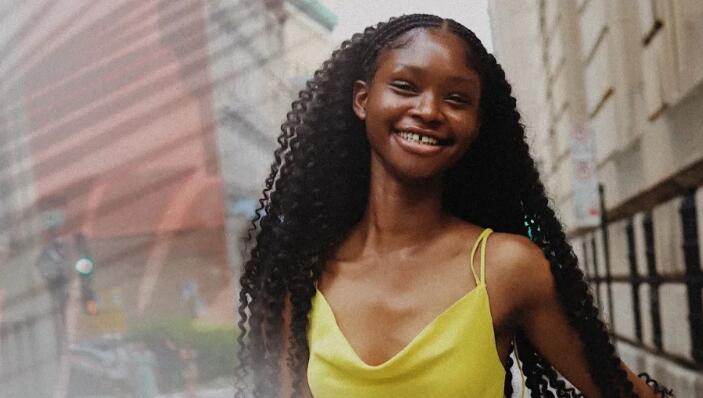

Today, the options for hair extensions are very wide. From clipping to stitching, microlinks and wigs, it’s no longer just for the rich and famous. Although, Ariana Grande did say it best when she sang, “Do you like my hair? Oops, thanks, just bought it.”
In addition to the types of hair extensions, the variety of hair textures available has also become more accessible. Whether you’re using a 2A wave or a 4C coil, you’ll find extension cords designed for all curling queens looking for extra length.
The only setback? Finding the right curl extension that matches your natural curl pattern can be tricky. This is why the process of buying hair extensions takes time and research. Luckily, we’ve asked two experts to discuss everything you need to know before extending your curls.
What do you need to consider before doing curls?
You need to consider the crimp pattern, density and length before getting an extension. “For a perfect blend, you should have enough hair to hide the extension wefts,” says Soleil Guerrero, creator of Bebonia Curly Hair Extensions. The founders add that your hair needs to be at least chin length for best results. “Next, think about the density of your hair, as this will determine how dense your extensions should be.”
LeAna McKnight, celebrity stylist and founder of SL Raw Virgin Hair, a brand of textured extensions, says figuring out your curl pattern can help you determine the density of your hair and extensions. “Knowing your curl pattern and hair type properly will help you determine how many strands of hair you need during the buying process and choose the right curl pattern that works best for your hair,” she says. Generally speaking, the finer your hair type, the less amount of hair you need, and vice versa.
What are the types of curly hair extensions?
McKnight explained that there are four types of texture extensions available. When choosing the type that’s best for you, you need to decide what hairstyle and goals you want to achieve, she says. Are you looking for versatility, protective style or extra length and bulk? “Depending on your choice, you may need a weft, a keratin I-tip link, a clip, or a wig,” she says.
Stitched wefts are great for adding length and density. “I-tips (similar to microlinks) are great for those who don’t like the tension but want something more permanent with awesome versatility,” says McKnight. “Clips are great for do-it-yourself (DIY) to add length and volume, while wigs are a great protective style and ideal for self-installation while adding volume and length.”
How do you style your curly hair?
To find the correct extension, you need to determine the curl mode. McKnight suggests cutting a hair and comparing it to the hairstyles on the curly pattern chart. “Usually curl extensions specify curl patterns of 2A-2C, 3A-3C, 4A-4C,” she said. “If you already know your curly hair type, this will be an easy match.”
However, if you don’t know your curl pattern, most hair extension companies offer exchange policies or help you decide which extension is best for you. For example, Bebonia offers a free personal matching service.
“We can consult in person or by photo,” Guerrero said. “When sending photos, make sure to take the selfie in natural light (preferably out of direct sunlight) so your curl pattern and color can be seen. When you order a set of Begonia hair extensions, you’ll get a test weft, This is to ensure that the extension can match your texture and color to your liking.” If the weft does not match, the company will accept returns or exchanges if the main compartment of the original packaging is still sealed.
The same goes for SL Raw Virgin Hair, which offers a 30-day warranty that allows you to exchange your unused curl extender for the correct curl pattern.
So, to reiterate, if you’re not sure what type of curl you have, be sure to check the exchange policy of the company you bought the extension from.
What is the installation process for curly hair extensions?
Installation will depend on the type of extension you choose. If you opt for clip-on extensions, Guerrero says one trick is to work from the bottom up. “Inverting the first weft to hide any shorter natural hair ends—this trick is a game-changer,” she says. “Create clear vertical sections that make installation easier.” Pro tip: Feel free to mix and match different curl patterns in your hair, Guerrero explains, since people naturally have two or three curl patterns in their hair. Also, never use the extender when your hair is damp or the extender itself is wet.
Other general tips for installing naturally curly hair extensions are to shampoo and condition your hair beforehand. “Most natural curly hair extensions are lightly steamed to achieve these curls and curls, so cleaning your hair before installing is a good preparation,” says McKnight. ” When you’re ready to install, open your hair extension kit gently and slowly part the curls one by one so you don’t loosen any curls that might gather together.”
How do you keep curly hair extensions?
If your extensions are made from human hair, maintenance will be similar to your curling routine. “Remember that curly hair extensions should be treated like real hair,” says McKnight. “You need to moisturize, detangle and protect your hair at night with a silk hat or scarf.
To minimize tangles and matting, use a detangling brush every day while wet, McKnight explains. She also recommends using a daily leave-in conditioner, starting at the ends of your hair and spreading it throughout your hair. “Your curl extensions will benefit from more frequent deep conditioning because they won’t benefit from the scalp’s natural oils the way your hair does,” Guerrero affirms.
In addition to conditioning, you also need to wash your extensions once a week, just like your natural hair. Another important part of maintenance is storage. Make sure you lay your extensions neatly in silk or satin in a cool, dry area. The purpose is to keep them from getting wet, tangled, or squished when you’re not wearing them.
How long does the curl extension last?
“If you comb properly, deep condition regularly, and store your extensions properly (in a dry area, stacked neatly, preferably with a satin/silk lining that won’t absorb moisture from your hair – like a satin storage bag) , your curls will last from six months to two years, depending on the level of care and wear,” says Guerrero.
It’s all natural. From the most frizzy curls to loose waves, we celebrate natural hair in all its forms by sharing expert tips on styling, maintenance and care.







